Last Updated on December 29, 2022 by asoulwindow
Table of Contents
Pink Tea,Samovar and other secrets – In Search of vegetarian food in Lucknow during Ramadan
I am not very fond of Massive Navratra Thalis or the meat heavy food frenzy which we see during the holy month of Ramadaan. Let holy festivals remain holy. The food mania which we see during both the festivals year after year are driven by the market forces who want to sell you the oil and spices rich food. Perhaps, they are systematically erasing the reason why we celebrate these festivals from our conscience.
The purpose of Ramadaan is fasting and not crazy feasting of the lavish spread that we often see. What is meant to be a time for elevated devotion, prayers, spiritual reflection, self-improvement and self control is reduced to a lavish buffet, overpriced dishes (which I saw in Dubai during Ramadan) and immense food wastage worldwide.
I will be preaching if I saw we should observe a simple and austere one month, like it originally must have been. That said, on the upside it also opens up a window for people who want to sample wide variety of dishes under one roof. I have taken only 3 Ramadan Walks till now. Being a vegetarian, I stick to sweets and the best ones I found in Lucknow. And I liked the austerity and authenticity of a Ramadan Walk in Lucknow.
I have spent my growing up years in Lucknow (Well 1998 to 2008) and after moving to Mumbai and then Delhi, I keep coming back to meet parents. But never had I explored the Ramadaan special food walks in the old city area. Perhaps, the vegetarian in me stopped me. This year I decided to explore the vegetarian delight during the month long festival.
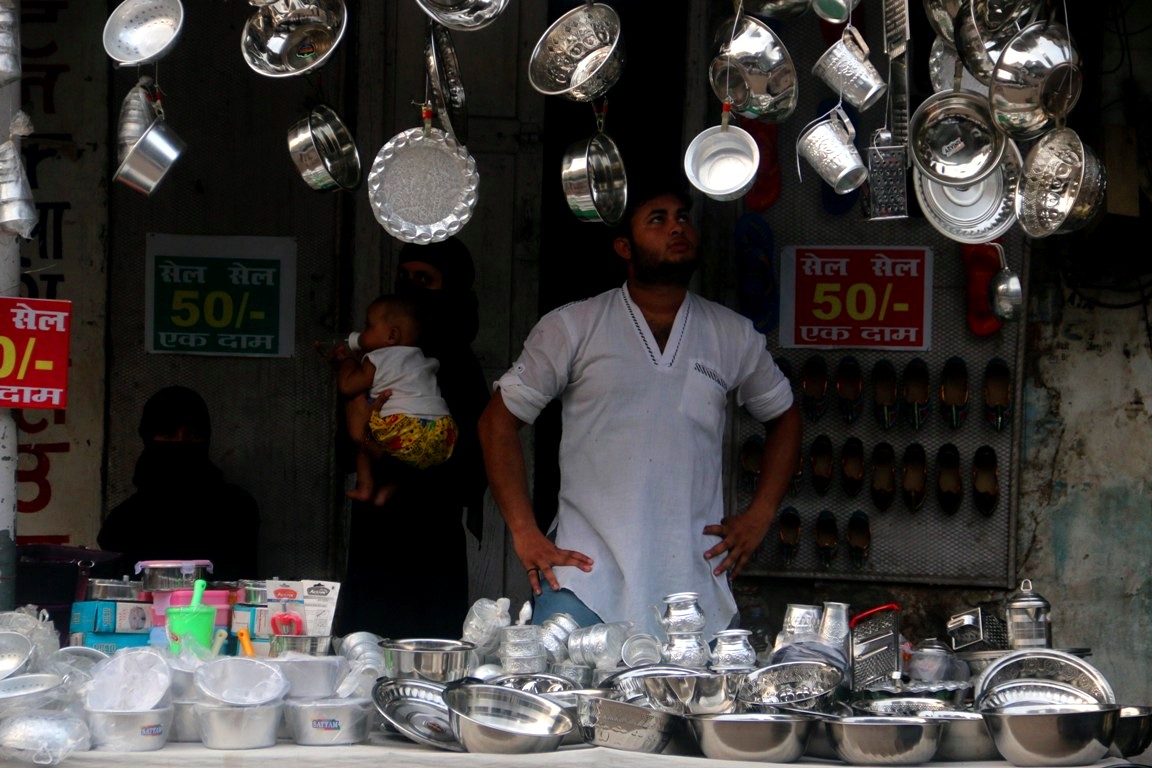
My photo researcher/photographer friend, Sneha Srivastava agreed to join me. She is on a sabbatical in Lucknow (and spends her time playing with her dog, attending mundane ‘mundan’ parties and other small joys in life.) We roamed around the lanes of very chaotic Akbari Gate. I was curious to locate an ancient gate when a vendor directed me to a narrow lane, the kind where two fat men can’t walk together. I was intrigued to find a dilapidated gate sandwiched by a mix of nondescript buildings.
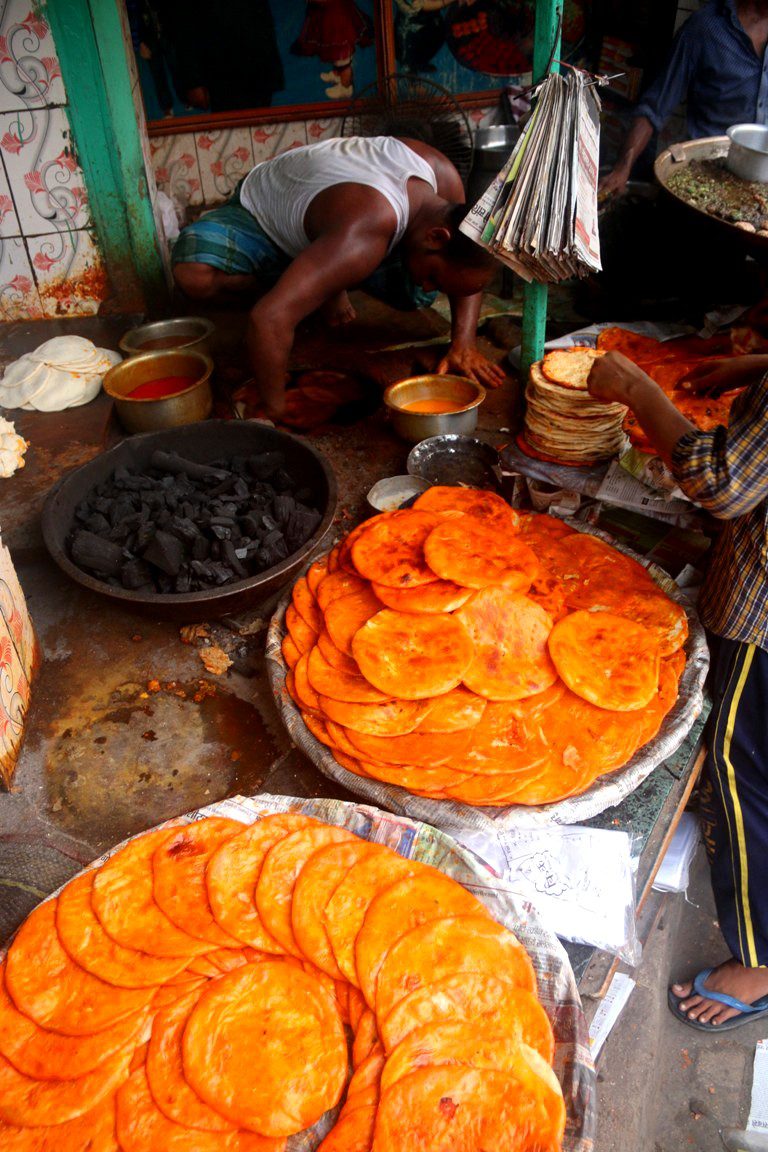
As we explored more lanes around the place, around 7:04 p.m., people in almost all the shops, sat around a buffet of home cooked food, performing their prayers and breaking the fast. A friendly person asked us to join them for the feast in a garments shop. I hesitantly agreed, suspecting the food to be a mix of vegetarian and non vegetarian fare. I was surprised when the gentleman told me that each item of the feast was ‘pure vegetarian’. Apparently, in Indian homes, in most Roza Iftaaris, the major chunk of food served is vegetarian.
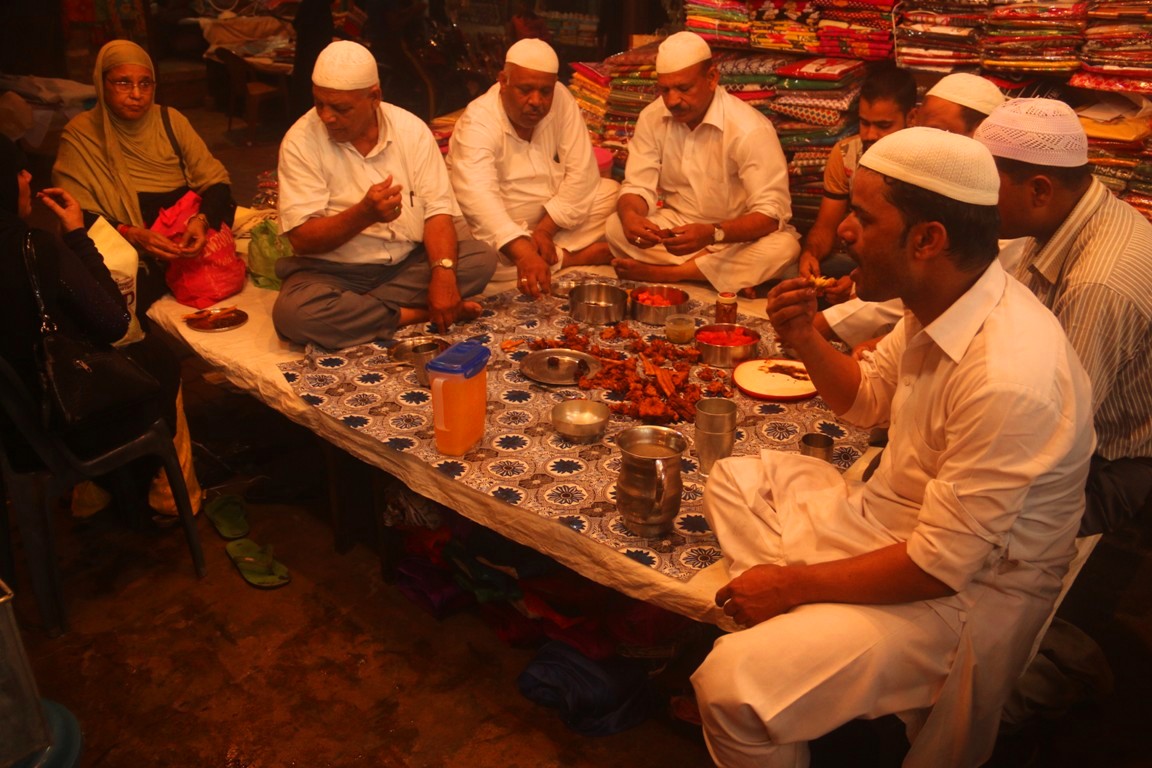
I wasn’t really observing Roza but I was more than happy to join them for iftari. Iftar means the meal eaten after sunset during Ramadan. They shared their black chanas (chickpeas), dates, pakoras (fritters) , desserts, cut fruits and ‘sherbet’ with me. Food was nothing to write home about. It was what you get in home but what made it special was the love and affection with which it was served to us.

When two burqa clad women who were passing by, asked them for water, they invited them to join. Within minutes, a cheerful friend of them joined them and spread the festive cheer with his upbeat mood. I understood in that moment, that this ritual is not only about self control,self restraint, sacrifice but also about bonding, bonhomie and sharing. As they sipped water from the old fashioned ‘katora’ (bowl), I thanked them for their hospitality and moved on.
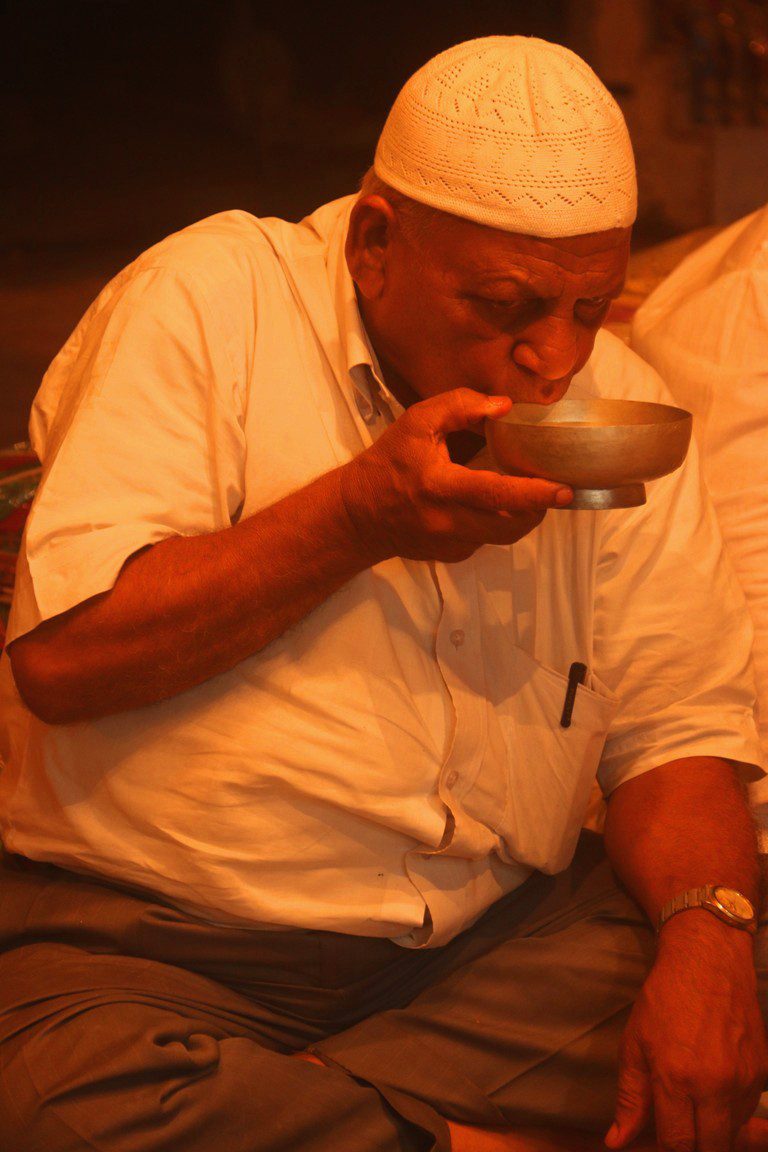
Near Akbari gate is the famous shop called Al Madina Lassi and Kashmiri Chai. The shop is mostly known for the meticulously made Kashmiri Noon Chai. It is run by 3 brothers, Munna, Wahid and Latif Munna gave me a lowdown on the process. He told me that the preparations start since morning.
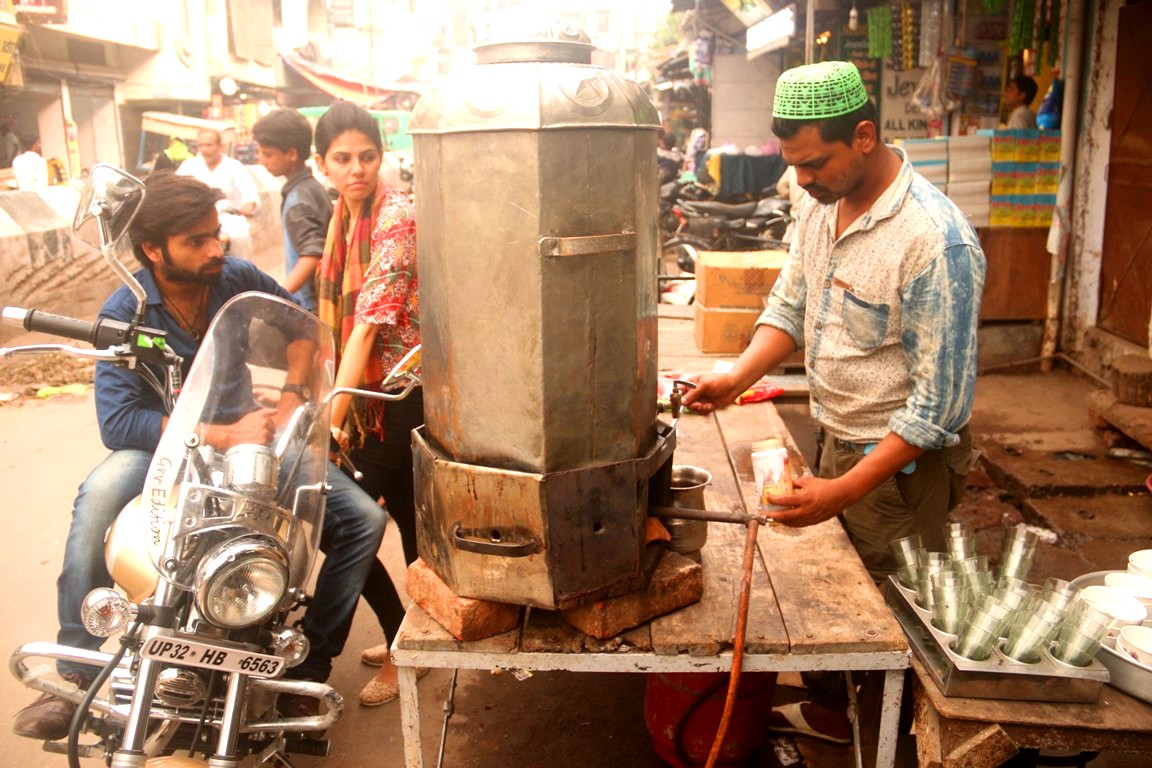
It was surprising for me to know that the Pink tea was made with the regular green tea. But the process was more meticulous. The shopkeeper, said ruefully (but also with a hint of pride), “It takes a lot of time to make this tea.” It tastes even better in winters, I was told. It also helps one keep warm in winter. Tea leaves are boiled in water for one hour or more along with baking soda. Once the tea leaves release dark color, it is boiled for four hours alongwith dried rose petals, dalchini (cinnamon), tejpatta (Bay Leaf), Kesar aka Jaffran (saffron), Ilaichi (Cardamom), laung (cloves) and khada namak (salt), milk, crushed almonds, sugar et al. The samovar (mostly made up of copper) adds to its distinct taste. It is then dispensed from the Samovar directly, everytime an order comes. You can also taste the delicious Kesariya kheer and lassi here.

On seeing our interest (and perhaps ‘peeled eyes’ expressions), an enthusiastic Daaud from a nearby shop invited us to sample dishes from his roadside shop. His brother Mohammed Sabir sells Kashmiri tea and desserts on his hand pulled cart. He showed us how to set up the Samovar. The Samovar has a lid which when opened, reveals a metal pipe which runs through the entire pot. The pipe is filled with burning coal/charcoals. They settle at the base on a metal web. The metal web is constantly fuelled by mild fire though an opening at the base. This helps keep the tea warm. A modern day thermos flask could have done the same job more easily and efficiently but I think some things should just be done the old way.

Apart from Middle east and some parts of Europe, the samovar is also quite popular in Russia. In fact these originated in Russia. They come in many beautifully crafted designs and shapes. Some people collect antique versions for the prized beauty. It also has a chimney for the smoke to escape. When not using it to keep tea warm, people use it to boil water for daily use, using anything from coal to pine cones. In many cultures, samovars are used during community feasts and festivals.

Also pronounced as Samaavar, Daood pronounced it as Samovar which is actually the Persian way of saying it. The samovar we saw was a Kashmiri version and was made up of copper. It was embellished with calligraphic motifs. I spotted floral designs. This work is known as ‘naqash’ Few days after my visit to Lucknow, I attended an Iranian film festival and observed that samovar was featured in many Iranian films as an important routine of everyday life. In fact, the event also had a desk with a display of Iranian style copper Samovar and cups.
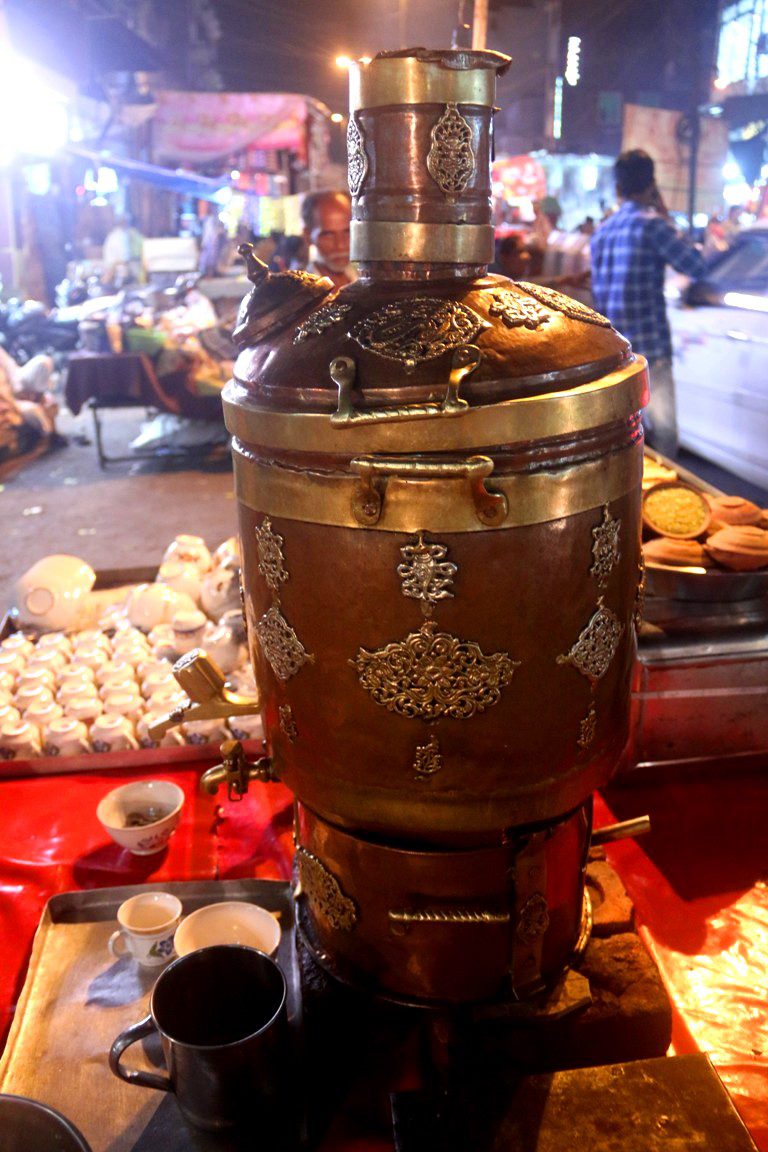
Kashmiri Noon Chai (It has a hint of salt) is also known as Pink Tea, Gulaabi chai (Pink in color) or Sheer Chai. It is though not as salty as the Butter Tea you get in Buddhist regions. It is neither as crisp as the kahwa, the other Kashmiri Chai. It is best consumed with breads like Lavasa, Sheermaal, Taftan Samosa, Balaai, Kulcha etc and is a part of daily routine in Kashmir and now some parts of Lucknow. The pink color is achieved by adding baking soda to it. Migrants from Kashmir brought this special tea with them to Lucknow. Today you can find this drink easily in the streets of Old Lucknow. The credit of popularizing it goes to Ameer Ahmad. He started selling it in 1962 on the streets of Lucknow on the suggestion of his mother. He dealt in the business of oil lamp prior to that. Ameer Started running a shop at Abdul Aziz road (Akbari gate). His son Rasheed Ahmad took over the legacy from him. Today’s Rasheed’s sons Waheed Ahmad and Munna (Moin Ahmad) and Lateef run the shop.
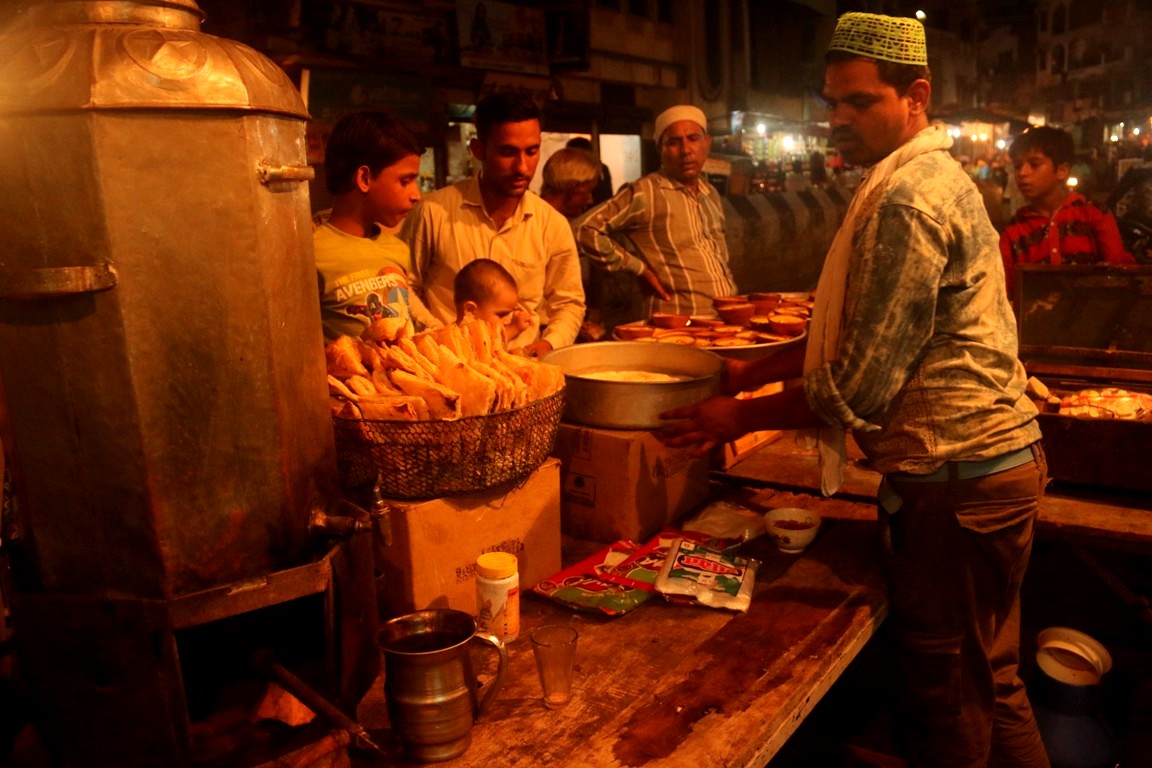
Though the Kashmiri tea costed me just Rs.10, a very interesting variation of the same came at a higher price. At Rs.40 a cup, Chai, samosa, malai ka pyala was nothing like what I have tasted before. Khari like puff pastry is crushed roughly and placed in a bowl. Then, it is topped with pink Kashmiri tea and thick malai (cream). It is quite filling and is meant to be savored leisurely as the crunchy puff pastry turns its texture into chewy.
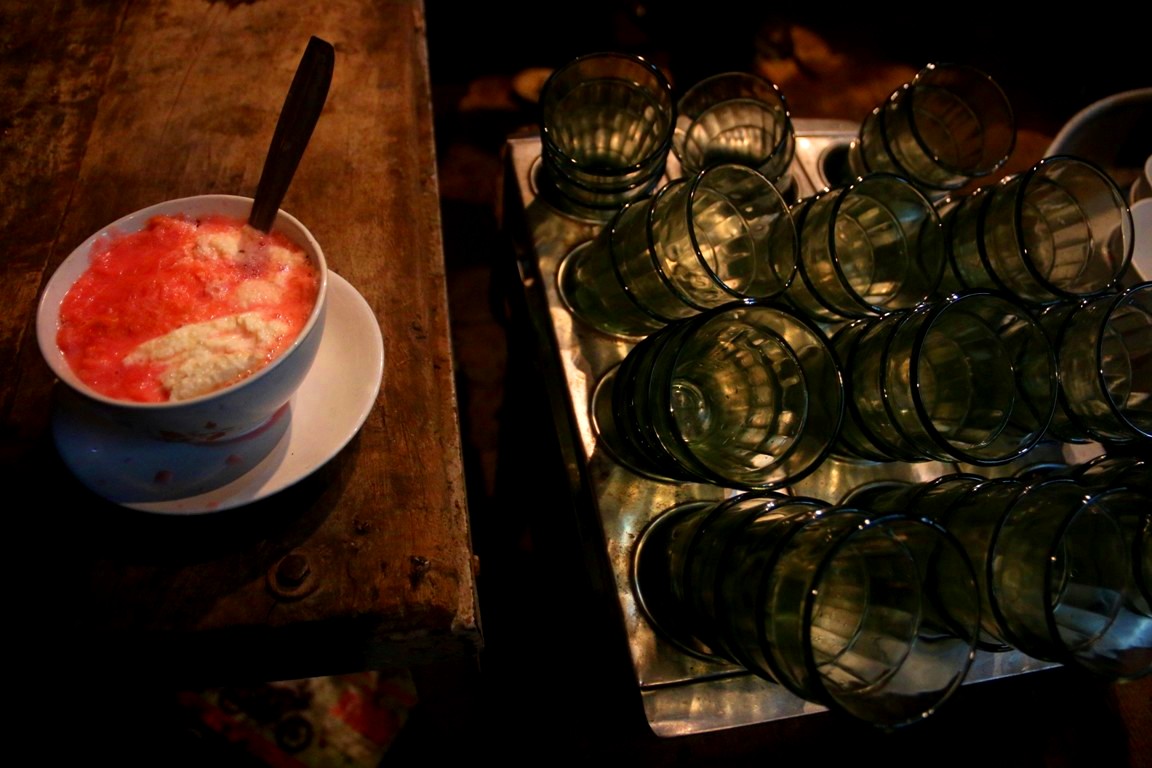
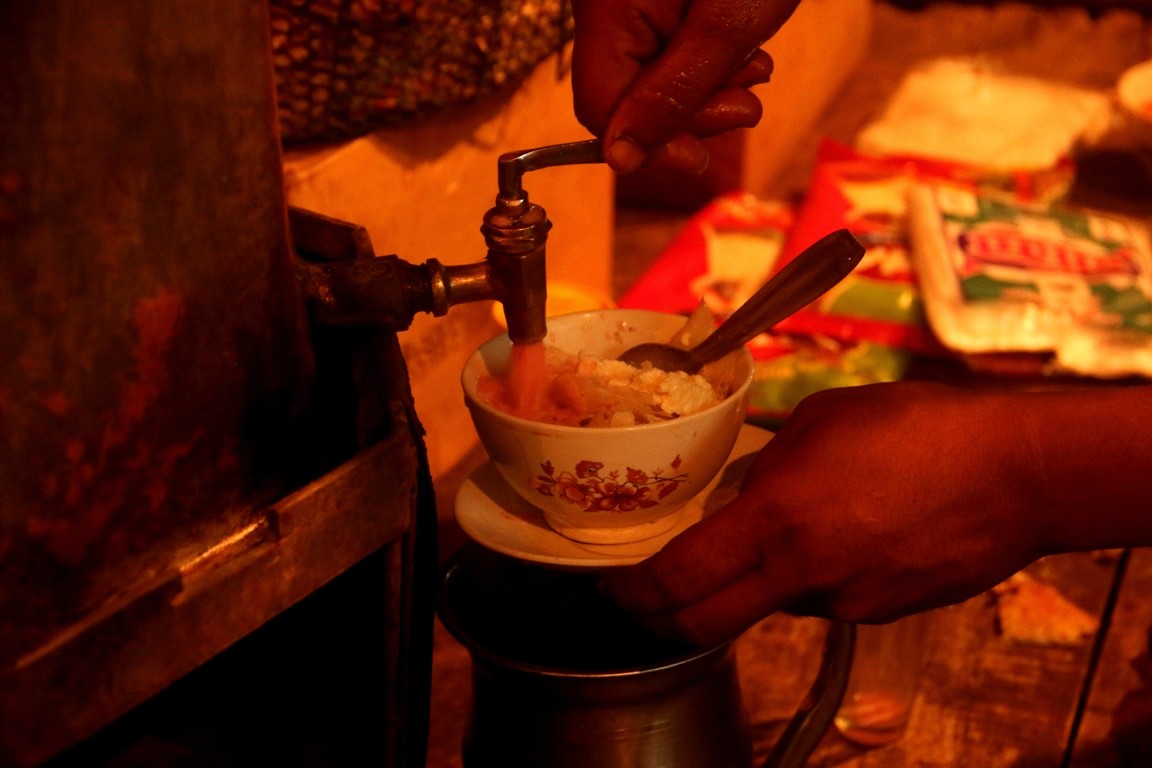
Pics above : Chai, samosa, malai ka pyala
Coming back to Dawood’s shop, the Shahi Tukda was passable (Though still worth a try) kheer was sure a winner. It was thick, creamy and had khoya, zaafran (Saffron), milk, dry fruits and rice in it. Rice is added whole and crushed during the cooking. It sure left me begging for more but I had to stop since Dawood bhai insisted that he won’t charge us a penny in spite of our protests. (Ah, the perks of a travel writer and sweet Lucknow people!) He also runs a shop where he sells only ‘besan ki roti’. It is shallow fried gramflour bread and is served with two spicy chutneys (Tomato and Chilly). Till the time I was there, I did not see the shopkeepers free for even a second. The rotis just flew off the tawa as the crowd gathered the cart. At Rs. 10 a piece, its great VFM.

Who knew the under rated city of Lucknow hides so many gems under its sleeve? A sequel of unique vegetarian dishes to eat in Lucknow is coming soon on the blog. Stay tuned.
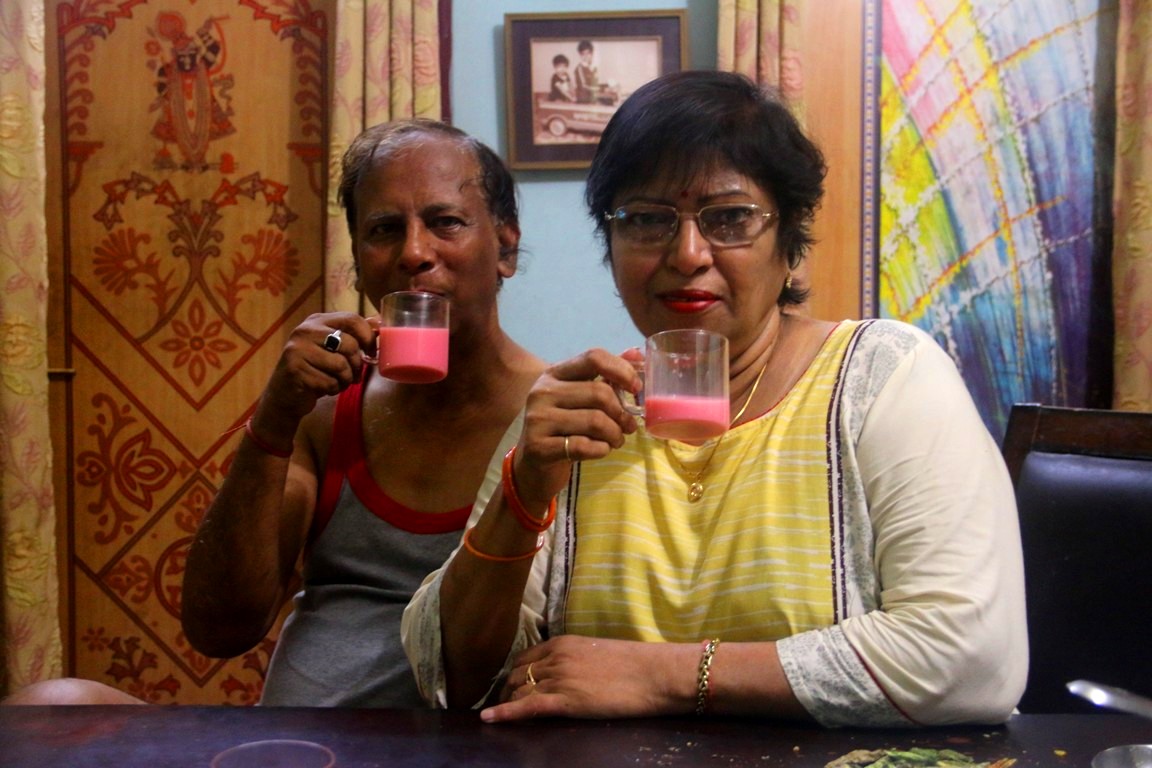
FIND THEM:
Al Madina Lassi And Kashmiri Chai : Abdul Aziz Road, Akbari Road Slope, Lucknow. Phone Waheed (9336166805), Munna (7068568426)
Dawood (For besan ki Roti, Pink Tea and Sweets) – Akbari Gate Slope, In Front of Umar Plaza, Lucknow. Phone – 9044140846
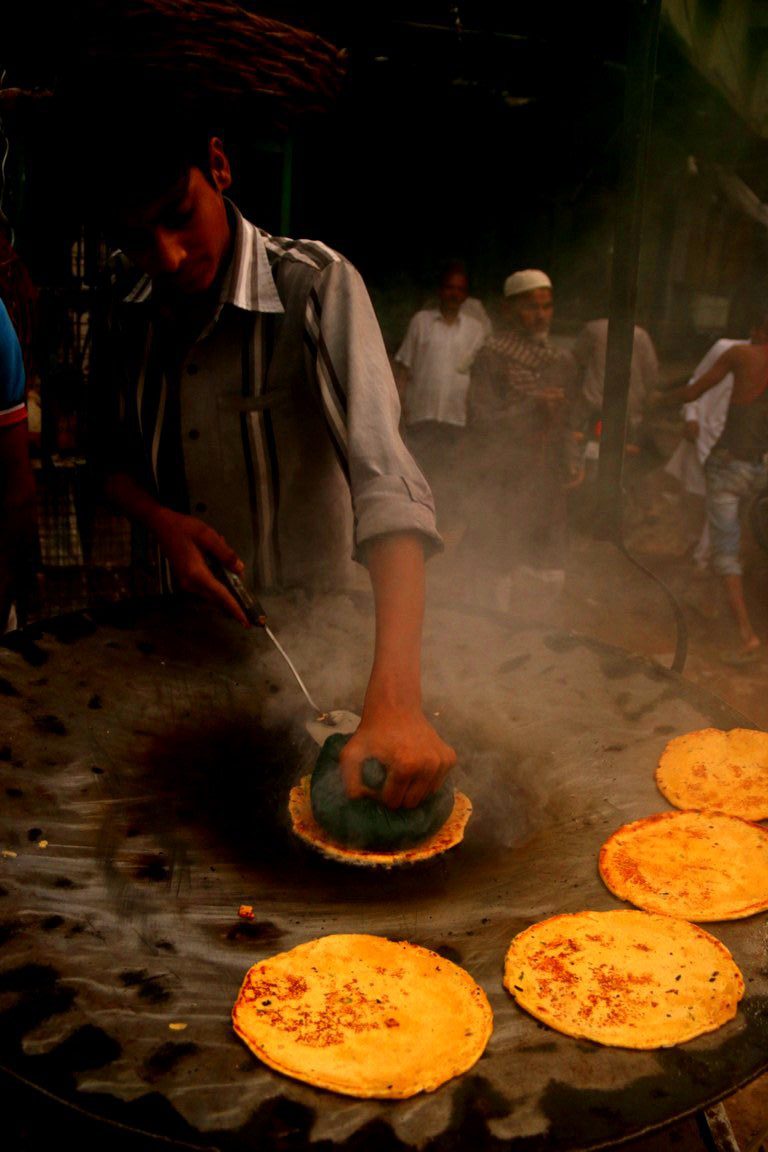
Spread the love, share this blog
Got any question/comments, ask in the comment section below so that it can benefit other readers.
Be a part of my journey on social media. The travel content I create there is different from this blog.
Pls subscribe/follow/like:
You Tube
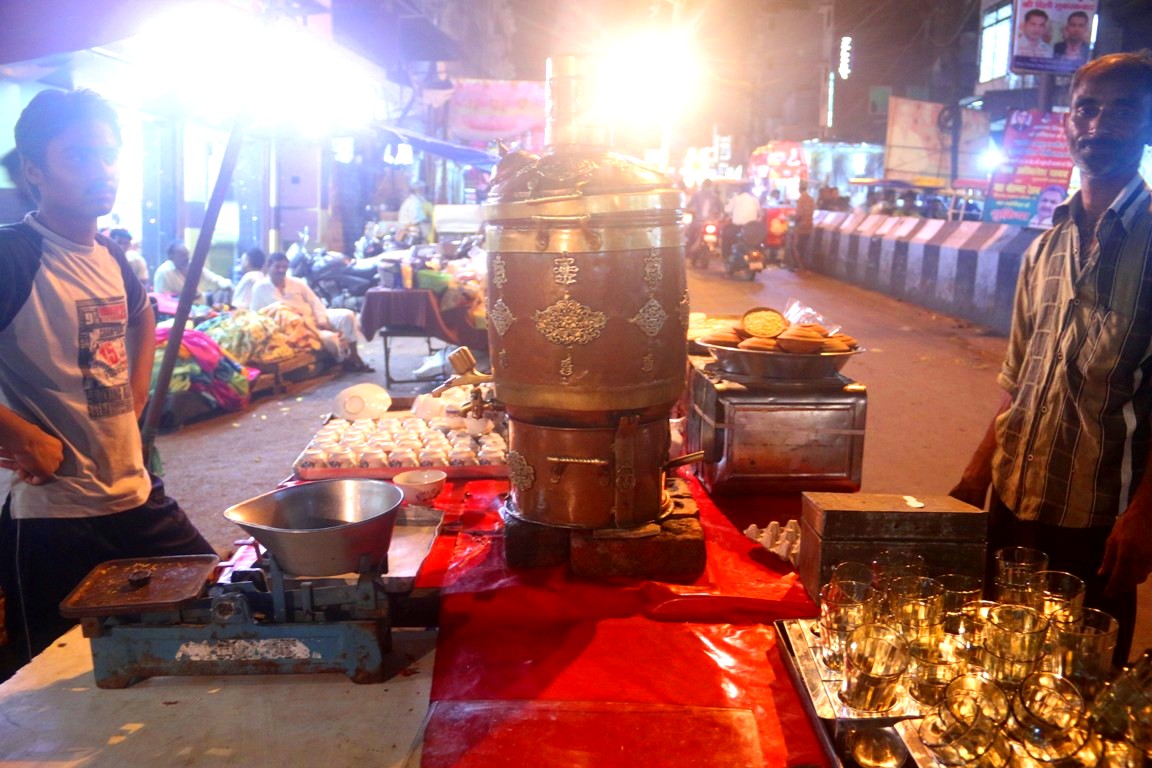
WARNING : COPYRIGHT TO ALL THE IMAGES AND TEXT HERE REMAINS WITH ME. YOU CAN NOT JUST LIFT THE CONTENT AND USE IT WITHOUT MY PERMISSION. STRICT LEGAL ACTION WILL BE TAKEN IF CONTENT IS STOLEN. YES, I AM SERIOUS.
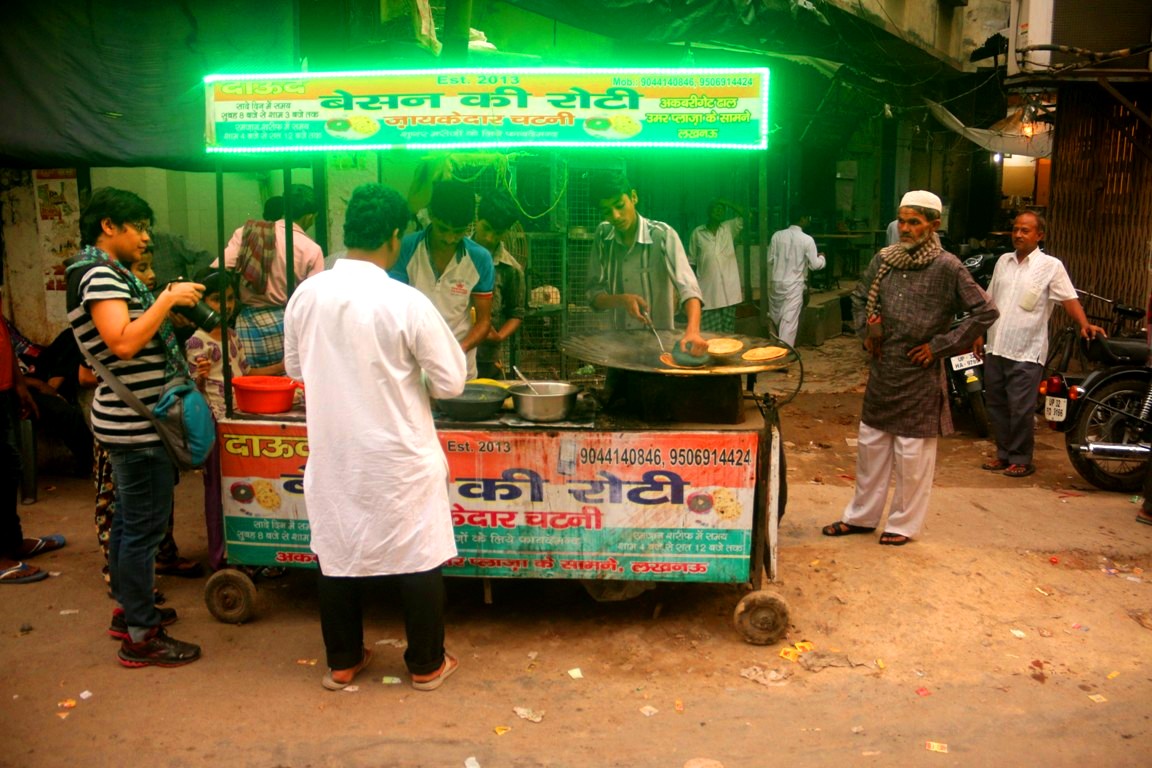
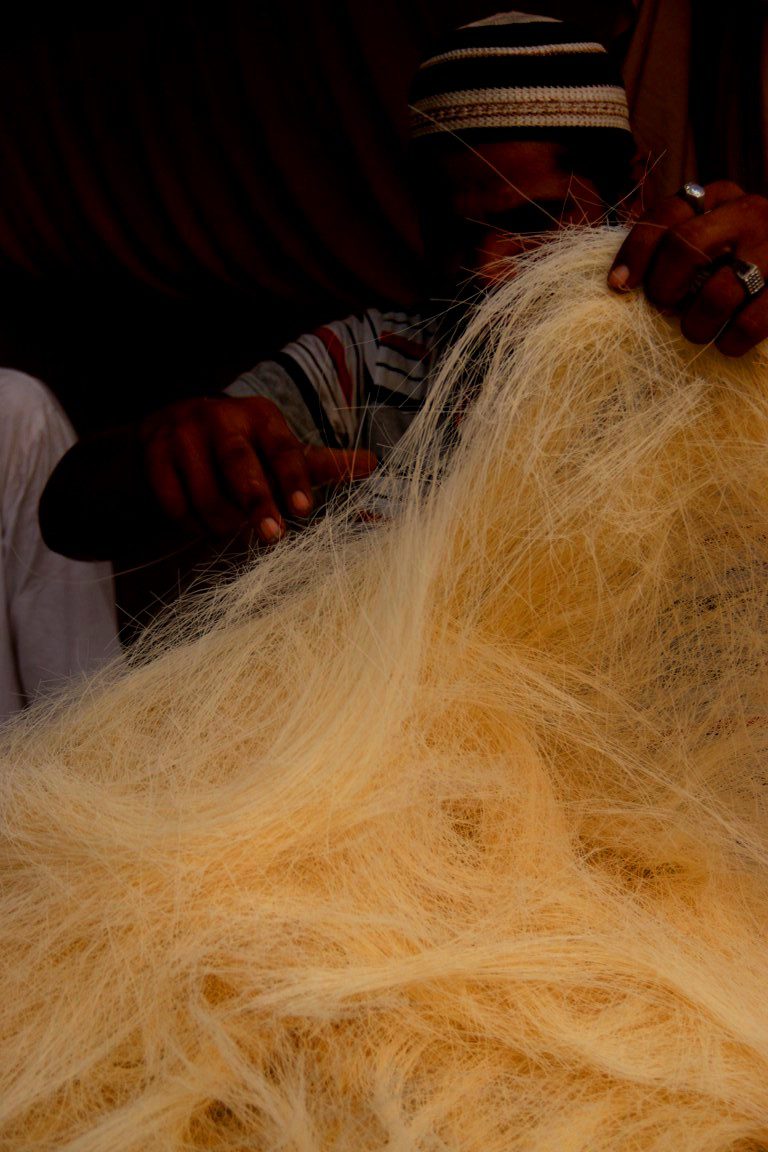
Top Travel Blogger from India
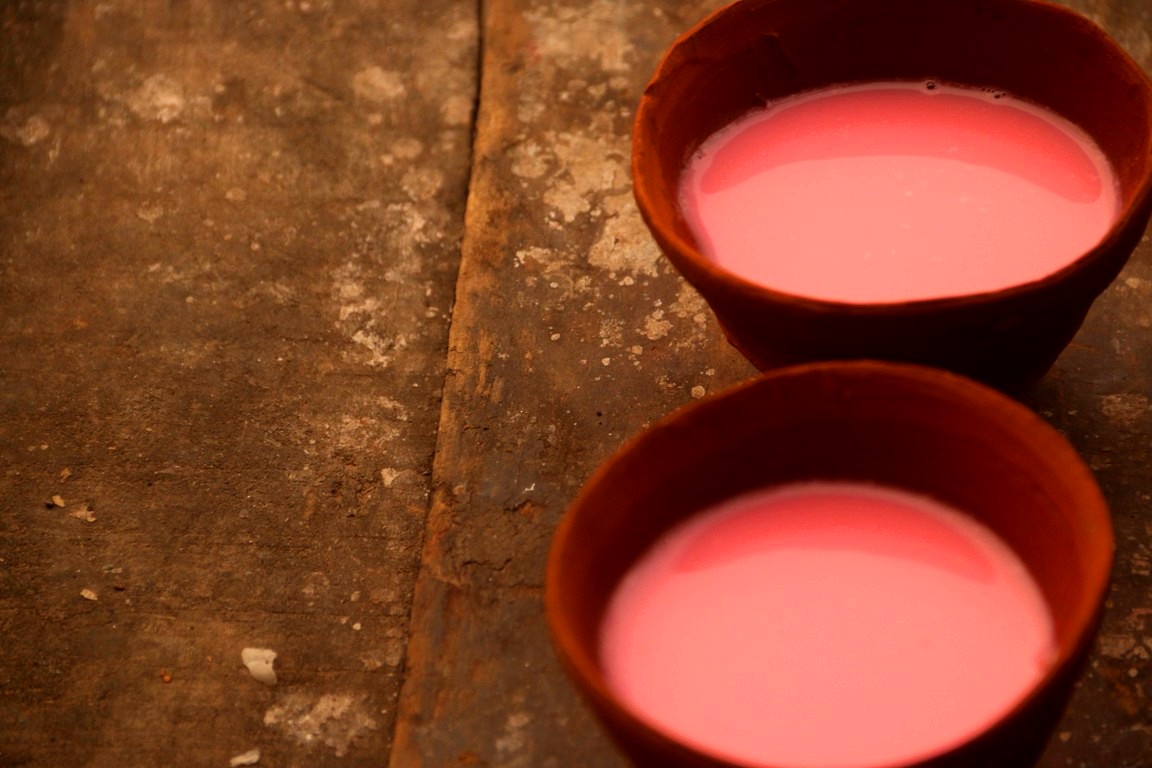
Pingback: 8 DAYS DETAILED ITINERARY OF BEST PLACES TO SEE IN FINLAND, EUROPE | A Soul Window - Top Travel Blog from India!
Pingback: HYATT REGENCY – ONE OF THE BEST 5 STAR HOTEL IN LUCKNOW ! | A Soul Window - Top Travel Blog from India!
thank you for the information. you can also buy kashmiri kahwa online from kashmir box.
Good to know that
Wow Amazing pic…. Exiting to have this!!! Mostly I think this places is there in uttar pradesh
Yes. It’s in Lucknow. Thank you.
Pingback: 2017 IS MY BEST TRAVEL YEAR AS BLOGGER FROM INDIA YET! A QUICK REVIEW! | A Soul Window - Top Travel Blog from India!
Pingback: IN SEARCH OF ONE HORNED RHINOCEROS & OTHER WILDLIFE IN CHITWAN NATIONAL PARK: NATURALLY NEPAL! | A Soul Window - Travel Blog from India!
Pingback: PORTRAITS & STORIES OF INTERESTING PEOPLE I MET IN PUSHKAR FAIR, RAJASTHAN. INCREDIBLE INDIA! | A Soul Window - Travel Blog from India!
Pingback: BEST AUTHENTIC RAJASTHANI VEGETARIAN AND VEGAN FOOD IN PUSHKAR FAIR! INCREDIBLE INDIA! | A Soul Window - Travel Blog from India!
It was pleasant experience, thanks for asking me to accompany you. 🙂
So hungry after reading this. Should have chosen another time of the day to read it ..or may be not, the effect would have still been the same! Excellent description and photographic evidence 🙂
Thank you Elita. I don’t blame you. Just reading about food and seeing food pictures makes me hungry too. Haha
I cannot imagine veg food in Ramzan! What a wonderful article Abhinav 🙂 being a vegetarian I was intrigued right from the beginning and now I can’t thank you enough for giving me another reason to visit Lucknow !
You are welcome. Next Ramzan, do try the vegetarian delicacies in whichever city you are. Though it would be great if you can make it to Lucknow.
Your photography is spectacular. You really capture the mood of the place and tell a fascinating story from a unique perspective. Beautiful article all around!
Thank you. So glad you liked it!
Loved every part of the food tour of Lucknow. The vegetarian fare is indeed a revelation. It is a misconception that most of the food during Ramzan is non-vegetarian. The Pink tea is another new discovery for me. And last but not the least are the stunning photos that have captured the essence of Ramzan in Lucknow.
I just love love this place for the food and of course my childhood memories.😐
I can totally relate to you!
Such an interesting and engaging post with some amazing pics!
Thank you for saying that!
very well written and informative. next time I would like to try some of these delicacies of Lucknow.
Yes, you must! I can’t wait for next Ramzan!
I am so glad you went for this walk. I hope you enjoyed the experience as much as I enjoyed reading about it. And that pic of the sewai paradise is a stunner. I like the way you include your parents in your trips and do things for them. It is a dying trait.
Thank you. It was your idea that I should go a Ramzan walk in Lucknow. I would have wasted my vacation had you not suggested. I think it is very important to give back to parents in whichever way we can!
Your pictures are amazing, I loved how you explained how the pink tea is made! We discovered so much about tea in Sri Lanka and it was really great.
Thank you. I am not a ‘Tea Person’ but off late I am getting attracted to different varieties of teas.
Something generally would not have thought of as a veggie… generally feel left out n such cases… thatnks for this one!!!
Thanks for stopping by. I never feel left out in India at least. There is always something for the vegetarians and even vegans in this country.
Never heard of pink tea – it looks great! Very interesting walk and post. Loved how you brought some chai back for your parents!
Thank you! My parents loved it!